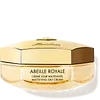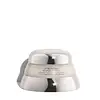What's inside
What's inside
 Key Ingredients
Key Ingredients

 Benefits
Benefits

 Concerns
Concerns

 Ingredients Side-by-side
Ingredients Side-by-side

Water
Skin ConditioningGlycerin
HumectantPropanediol
SolventC15-19 Alkane
SolventIsononyl Isononanoate
EmollientMel
EmollientJojoba Esters
EmollientGlyceryl Stearate
EmollientPEG-100 Stearate
Cellulose
AbsorbentAmmonium Acryloyldimethyltaurate/Vp Copolymer
Cetyl Alcohol
EmollientDimethicone
EmollientStearyl Alcohol
EmollientRoyal Jelly
Phenoxyethanol
PreservativeAscorbyl Glucoside
AntioxidantCaprylyl Glycol
EmollientSteareth-21
CleansingParfum
MaskingButyrospermum Parkii Butter
Skin ConditioningAcrylates/C10-30 Alkyl Acrylate Crosspolymer
Emulsion StabilisingAvena Sativa Kernel Extract
AbrasiveTocopheryl Acetate
AntioxidantXanthan Gum
EmulsifyingSodium Hydroxide
BufferingTetrasodium EDTA
Glyceryl Polymethacrylate
Centella Asiatica Leaf Extract
Skin ConditioningSodium Hyaluronate
HumectantGlycyrrhiza Glabra Root Extract
BleachingPEG-8
HumectantTocopherol
AntioxidantSodium Benzoate
MaskingHyaluronic Acid
HumectantButylene Glycol
HumectantSodium Lactate
BufferingZingiber Officinale Root Extract
MaskingBHT
AntioxidantPalmitoyl Hexapeptide-12
Skin ConditioningCitric Acid
BufferingWater, Glycerin, Propanediol, C15-19 Alkane, Isononyl Isononanoate, Mel, Jojoba Esters, Glyceryl Stearate, PEG-100 Stearate, Cellulose, Ammonium Acryloyldimethyltaurate/Vp Copolymer, Cetyl Alcohol, Dimethicone, Stearyl Alcohol, Royal Jelly, Phenoxyethanol, Ascorbyl Glucoside, Caprylyl Glycol, Steareth-21, Parfum, Butyrospermum Parkii Butter, Acrylates/C10-30 Alkyl Acrylate Crosspolymer, Avena Sativa Kernel Extract, Tocopheryl Acetate, Xanthan Gum, Sodium Hydroxide, Tetrasodium EDTA, Glyceryl Polymethacrylate, Centella Asiatica Leaf Extract, Sodium Hyaluronate, Glycyrrhiza Glabra Root Extract, PEG-8, Tocopherol, Sodium Benzoate, Hyaluronic Acid, Butylene Glycol, Sodium Lactate, Zingiber Officinale Root Extract, BHT, Palmitoyl Hexapeptide-12, Citric Acid
Water
Skin ConditioningGlycerin
HumectantButylene Glycol
HumectantIsododecane
EmollientIsohexadecane
EmollientDimethicone
EmollientCetyl Ethylhexanoate
EmollientHydrogenated Polydecene
EmollientDisteardimonium Hectorite
StabilisingPEG-9 Polydimethylsiloxyethyl Dimethicone
EmulsifyingPEG-150
HumectantPEG-8 Diisostearate
EmulsifyingPhenoxyethanol
PreservativeMethylparaben
PreservativeEthylparaben
PreservativePhytosteryl Macadamiate
Skin ConditioningSodium Citrate
BufferingParfum
MaskingTrisodium EDTA
Tocopheryl Acetate
AntioxidantStearyl Glycyrrhetinate
Skin ConditioningHydroxyproline
Skin ConditioningCitric Acid
BufferingSodium Metaphosphate
BufferingBenzyl Benzoate
AntimicrobialAlpha-Isomethyl Ionone
PerfumingButylphenyl Methylpropional
PerfumingHexyl Cinnamal
PerfumingLinalool
PerfumingLimonene
PerfumingSodium Acetylated Hyaluronate
HumectantCitronellol
PerfumingGeraniol
PerfumingSaccharomyces Ferment Lysate Filtrate
Skin ConditioningRubus Idaeus Fruit Extract
AstringentCI 77492
Cosmetic ColorantSyzygium Jambos Leaf Extract
Skin ConditioningCI 77491
Cosmetic ColorantTocopherol
AntioxidantWater, Glycerin, Butylene Glycol, Isododecane, Isohexadecane, Dimethicone, Cetyl Ethylhexanoate, Hydrogenated Polydecene, Disteardimonium Hectorite, PEG-9 Polydimethylsiloxyethyl Dimethicone, PEG-150, PEG-8 Diisostearate, Phenoxyethanol, Methylparaben, Ethylparaben, Phytosteryl Macadamiate, Sodium Citrate, Parfum, Trisodium EDTA, Tocopheryl Acetate, Stearyl Glycyrrhetinate, Hydroxyproline, Citric Acid, Sodium Metaphosphate, Benzyl Benzoate, Alpha-Isomethyl Ionone, Butylphenyl Methylpropional, Hexyl Cinnamal, Linalool, Limonene, Sodium Acetylated Hyaluronate, Citronellol, Geraniol, Saccharomyces Ferment Lysate Filtrate, Rubus Idaeus Fruit Extract, CI 77492, Syzygium Jambos Leaf Extract, CI 77491, Tocopherol
 Reviews
Reviews

Ingredients Explained
These ingredients are found in both products.
Ingredients higher up in an ingredient list are typically present in a larger amount.
Butylene Glycol (or BG) is used within cosmetic products for a few different reasons:
Overall, Butylene Glycol is a safe and well-rounded ingredient that works well with other ingredients.
Though this ingredient works well with most skin types, some people with sensitive skin may experience a reaction such as allergic rashes, closed comedones, or itchiness.
Learn more about Butylene GlycolCitric Acid is an alpha hydroxy acid (AHA) naturally found in citrus fruits like oranges, lemons, and limes.
Like other AHAs, citric acid can exfoliate skin by breaking down the bonds that hold dead skin cells together. This helps reveal smoother and brighter skin underneath.
However, this exfoliating effect only happens at high concentrations (20%) which can be hard to find in cosmetic products.
Due to this, citric acid is usually included in small amounts as a pH adjuster. This helps keep products slightly more acidic and compatible with skin's natural pH.
In skincare formulas, citric acid can:
While it can provide some skin benefits, research shows lactic acid and glycolic acid are generally more effective and less irritating exfoliants.
Most citric acid used in skincare today is made by fermenting sugars (usually from molasses). This synthetic version is identical to the natural citrus form but easier to stabilize and use in formulations.
Read more about some other popular AHA's here:
Learn more about Citric AcidDimethicone is a type of synthetic silicone created from natural materials such as quartz.
What it does:
Dimethicone comes in different viscosities:
Depending on the viscosity, dimethicone has different properties.
Ingredients lists don't always show which type is used, so we recommend reaching out to the brand if you have questions about the viscosity.
This ingredient is unlikely to cause irritation because it does not get absorbed into skin. However, people with silicone allergies should be careful about using this ingredient.
Note: Dimethicone may contribute to pilling. This is because it is not oil or water soluble, so pilling may occur when layered with products. When mixed with heavy oils in a formula, the outcome is also quite greasy.
Learn more about DimethiconeGlycerin is already naturally found in your skin. It helps moisturize and protect your skin.
A study from 2016 found glycerin to be more effective as a humectant than AHAs and hyaluronic acid.
As a humectant, it helps the skin stay hydrated by pulling moisture to your skin. The low molecular weight of glycerin allows it to pull moisture into the deeper layers of your skin.
Hydrated skin improves your skin barrier; Your skin barrier helps protect against irritants and bacteria.
Glycerin has also been found to have antimicrobial and antiviral properties. Due to these properties, glycerin is often used in wound and burn treatments.
In cosmetics, glycerin is usually derived from plants such as soybean or palm. However, it can also be sourced from animals, such as tallow or animal fat.
This ingredient is organic, colorless, odorless, and non-toxic.
Glycerin is the name for this ingredient in American English. British English uses Glycerol/Glycerine.
Learn more about GlycerinParfum is a catch-all term for an ingredient or more that is used to give a scent to products.
Also called "fragrance", this ingredient can be a blend of hundreds of chemicals or plant oils. This means every product with "fragrance" or "parfum" in the ingredients list is a different mixture.
For instance, Habanolide is a proprietary trade name for a specific aroma chemical. When used as a fragrance ingredient in cosmetics, most aroma chemicals fall under the broad labeling category of “FRAGRANCE” or “PARFUM” according to EU and US regulations.
The term 'parfum' or 'fragrance' is not regulated in many countries. In many cases, it is up to the brand to define this term.
For instance, many brands choose to label themselves as "fragrance-free" because they are not using synthetic fragrances. However, their products may still contain ingredients such as essential oils that are considered a fragrance by INCI standards.
One example is Calendula flower extract. Calendula is an essential oil that still imparts a scent or 'fragrance'.
Depending on the blend, the ingredients in the mixture can cause allergies and sensitivities on the skin. Some ingredients that are known EU allergens include linalool and citronellol.
Parfum can also be used to mask or cover an unpleasant scent.
The bottom line is: not all fragrances/parfum/ingredients are created equally. If you are worried about fragrances, we recommend taking a closer look at an ingredient. And of course, we always recommend speaking with a professional.
Learn more about ParfumPhenoxyethanol is a preservative that has germicide, antimicrobial, and aromatic properties. Studies show that phenoxyethanol can prevent microbial growth. By itself, it has a scent that is similar to that of a rose.
It's often used in formulations along with Caprylyl Glycol to preserve the shelf life of products.
Tocopherol (also known as Vitamin E) is a common antioxidant used to help protect the skin from free-radicals and strengthen the skin barrier. It's also fat soluble - this means our skin is great at absorbing it.
Vitamin E also helps keep your natural skin lipids healthy. Your lipid skin barrier naturally consists of lipids, ceramides, and fatty acids. Vitamin E offers extra protection for your skin’s lipid barrier, keeping your skin healthy and nourished.
Another benefit is a bit of UV protection. Vitamin E helps reduce the damage caused by UVB rays. (It should not replace your sunscreen). Combining it with Vitamin C can decrease sunburned cells and hyperpigmentation after UV exposure.
You might have noticed Vitamin E + C often paired together. This is because it is great at stabilizing Vitamin C. Using the two together helps increase the effectiveness of both ingredients.
There are often claims that Vitamin E can reduce/prevent scarring, but these claims haven't been confirmed by scientific research.
Learn more about TocopherolTocopheryl Acetate is AKA Vitamin E. It is an antioxidant and protects your skin from free radicals. Free radicals damage the skin by breaking down collagen.
One study found using Tocopheryl Acetate with Vitamin C decreased the number of sunburned cells.
Tocopheryl Acetate is commonly found in both skincare and dietary supplements.
Learn more about Tocopheryl AcetateWater. It's the most common cosmetic ingredient of all. You'll usually see it at the top of ingredient lists, meaning that it makes up the largest part of the product.
So why is it so popular? Water most often acts as a solvent - this means that it helps dissolve other ingredients into the formulation.
You'll also recognize water as that liquid we all need to stay alive. If you see this, drink a glass of water. Stay hydrated!
Learn more about Water